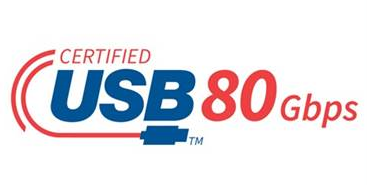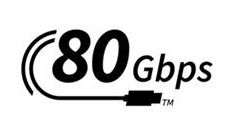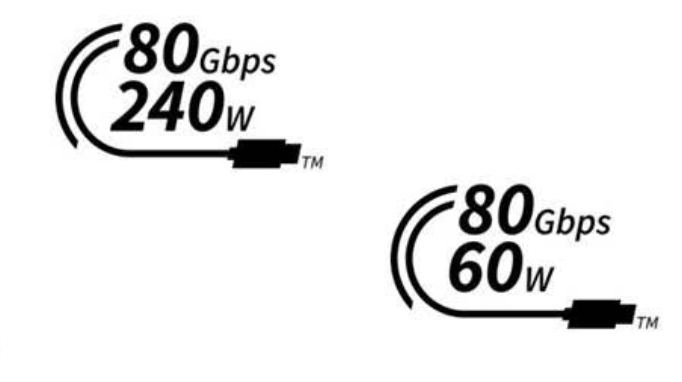USB 4's 80 Gbps Spec Released Alongside New Logos

First announced last month, USB4 Version 2.0 now has official specification documents for developers to follow. The USB-IF (USB Implementer's Forum), the governing body for USB, published the new documentation on its website, at the same time releasing new "USB 80 Gbps" certification logos that can be used on USB cables and devices that reach the 80 Gbps speed.
USB 4 (technically USB4 but commonly spelled with a space) was announced in 2019 and supports up to 40 Gbps connections while offering cross-compatibility with Thunderbolt 3 and 4. USB 4 version 2.0 doubles the maximum speed to 80 Gbps but can go even higher, up to 120 Gbps in one direction (with 40 Gbps downlink) to power high-resolution monitors.
Using USB4 v2.0's bandwidth, the standard is fully compatible DisplayPort 2.1 and can power a 4K display at up to 240 Hz, or up to a 10K display at 60 Hz, without the need for compression.
"This updated technical specification extends USB4 speed and data protocol performance, enabling manufacturers to develop products that can deliver USB 80 Gbps in addition to existing USB 40 Gbps and USB 20 Gbps to end users," USB-IF CEO Brad Saunders said in an official statement.
USB4 version 2.0 will work over both existing USB4 40 Gbps passive cables and new, active 80 Gbps cables. In addition to being compatible with DisplayPort 2.1, it will be, according to USB-IF, "closely aligned" with PCIe 4.0.
Considering that the original USB 4 spec was announced in 2019 and we've just started seeing USB 4-branded products in the past few months, we don't expect any USB4 v2.0 devices to hit the market for a year or two. However, when USB4 v2.0 devices go on sale, you may see the new USB 80 Gbps logo on their packaging or even on their ports.
USB-IF has told Tom's Hardware on several occasions that it doesn't want consumers to have to think about version numbers when they're shopping for products. Instead, the group wants manufacturers to promote the maximum speed of all USB products, using monikers and logos such as USB 5 Gbps, USB 10 Gbps, USB 20 Gbps, USB 40 Gbps, and now USB 80 Gbps.
Products that go through the organization's official certification process will be able to use a "Certified 80 Gbps" logo on packages.
Get Tom's Hardware's best news and in-depth reviews, straight to your inbox.

Other devices or even computers that support 80 Gbps connections will be able to use the 80 Gbps port logo if they are certified.

Cables that are certified will carry an 80 Gbps, 240W logo if they can output 240 watts, or an 80 Gbps, 60W logo for 60 watts.

It's important to note that most USB products are not certified so, even when 80 Gbps devices and cables come out, you may not see these logos. And though the USB-IF would like manufacturers to talk about speeds and power output in their marketing materials, you will still see product listings that only mention USB 4 v2.0, USB 4, or USB 3.2, without listing the Gbps.
To help you make sense of all the version numbers, we have a detailed USB explainer and a special deep dive on USB 3.2 and USB 3.1
Avram Piltch is Managing Editor: Special Projects. When he's not playing with the latest gadgets at work or putting on VR helmets at trade shows, you'll find him rooting his phone, taking apart his PC, or coding plugins. With his technical knowledge and passion for testing, Avram developed many real-world benchmarks, including our laptop battery test.
-
spongiemaster Are there any USB 4 devices yet? And we're already on USB 4 V2.0. Is there any standard with a more confusing naming scheme than USB?Reply -
RichardtST So, like 4 different logos for the new generation of USB 4. That's nice. Between all these versions, the HDMI versions, and the DP versions, I've got enough cables to run an undersea connection to French Polynesia, where you will find me trying to memorize all the various combinations. Seriously though, this is getting ridiculous. It has to stop. Someone please find a permanent solution!Reply -
Colif Reply
So far all I have found is a few cables and an nvme enclosure https://www.orico.cc/us/product/detail/7328.htmlspongiemaster said:Are there any USB 4 devices yet? And we're already on USB 4 V2.0. Is there any standard with a more confusing naming scheme than USB?
Expecting lots of fakes though. -
JamesJones44 ReplyRichardtST said:So, like 4 different logos for the new generation of USB 4. That's nice. Between all these versions, the HDMI versions, and the DP versions, I've got enough cables to run an undersea connection to French Polynesia, where you will find me trying to memorize all the various combinations. Seriously though, this is getting ridiculous. It has to stop. Someone please find a permanent solution!
The issue is power and speed vs cost. If they force everyone to make one cable capable of 80 Gbps and 240 watts with active management then everyone is going to get upset that a 6 inch cable costs $15. The only ways to make it stop is break the laws of physics, come up with a room temperature super conductor on the cheap or remove features from USB. -
dehjomz So where is the first USB 80 Gbps controller chip? Maple Ridge as we know maxes out at 40 Gbps, and on the latest NVMs, it doesn't properly support hotplugging of certain older Alpine Ridge devices (i.e., JHL6240).Reply
I'm looking forward to hopefully a new Intel thunderbolt 5 controller or an USB4 80 Gbps controller from AsMedia MediaTek or some other entity. With full hotplugging support of older devices Full speed ahead! Seems that Intel z790 /Raptor Lake are still using the 'older' 40 Gbps technology, and we'll have to wait until at least MTL next fall for 80 Gbps on motherboards. -
InvalidError Reply
The USB spec is becoming far too bloated. I'm very much in favor of a whole new connector dedicated to 20+Gbps high-speed/60+W high-power devices.JamesJones44 said:The only ways to make it stop is break the laws of physics, come up with a room temperature super conductor on the cheap or remove features from USB. -
Kamen Rider Blade Reply
Or we can just Update USB 4.X to support Type-A & Type-B plugs and update the lonely single Full Duplex SuperSpeed Channel to support the latest protocols & speeds.InvalidError said:The USB spec is becoming far too bloated. I'm very much in favor of a whole new connector dedicated to 20+Gbps high-speed/60+W high-power devices.
No need to reinvent the wheel, we can just use a existing plug that just needs a micro controller chip updates on both ends to the new specification.
Then you can have a SuperSpeed Type A port capable of 20 Gbps & 40 Gbps @ Full Duplex speeds.
If you want Assymetric Speeds, you can have 40 Gbps & 80 Gbps one direction with USB 2.0 speeds covering the opposite direction for Temporary SpeedBoosts.
And USB Type-A can handle up to 60 watts according to official USB PD specs.
So charging wise, you're good.
Also SuperSpeed branding should be used as the label for all <Integer ###> Gbps bandwidths.
As long as your bandwidth is > 1.0 Gbps, it should be considered "SuperSpeed" class.
This way you don't conflict with legacy branding.
That's the problem with USB Type-C.JamesJones44 said:The issue is power and speed vs cost. If they force everyone to make one cable capable of 80 Gbps and 240 watts with active management then everyone is going to get upset that a 6 inch cable costs $15. The only ways to make it stop is break the laws of physics, come up with a room temperature super conductor on the cheap or remove features from USB.
Everybody that thinks "One Cable to Rule them All" is the solution.
Well you run into the issue where it's one cable that needs to do everything and that gets VERY expensive.
Does it do what you want, yes. Is it cheap, HELL NO!
That's why I think updating SuperSpeed USB Type-A/B ports to support the latest bandwidths / protocols is paramount.
A SuperSpeed Type-A/B port with the latest specs can support up to 40 Gbps @ Full Duplex communication speeds and 80 Gbps in a Assymetric configuration with USB 2.0 for the other direction.
It's a "Good Enough" solution.
And we need a cheaper new USB Nano-A port that offers Full Duplex HiSpeed USB 2.1 that fixes any of the flaws with the original USB 2.0 spec.
The Nano-A port would be square shaped and Fully reversible, and smaller tha a 3.5 mm Headphone jack in Diameter.
Imagine the new wired interconnects that can be made with such a slim & tiny cord based on USB Type-C's micro pins.
We also need a USB Mini-C connector that replaces the old SuperSpeed Micro-B, but is a Single Lane at Full Duplex.
Given that regular Type-C is Multi-Lane and with non-standard configurations, can have more than 2x SuperSpeed lanes, you should be able to see where I'm going with this.
Type-C will be the Large Bandwdith connector to the USB Root Port.
SuperSpeed Type-A/B ports or Mini-C will be the Medium Bandwidth for most devices.
HiSpeed Nano-A will offer smaller devices that need Low Bandwidth and tiny form factor along with a fully reversible setup.
It solves the problem of the "Ultra Expensive" port trying to rule everything. We don't need everybody buying "Ultra Big Gulps" sized Bandwidth connectors to solve everything.
We need finesse, the right size solution for every job. -
thisisaname Can this new cable/port be used in Europe or does the standard have to change to allow it?Reply -
InvalidError Reply
I wrote 60+W, so 60W would barely hit the minimum hypothetically guaranteed by USB4v2.0-gen4x2b. In a "one plug for everything" ecosystem, you need to think about things like bus-powered monitors with built-in high-powered hubs, in which case you need 20-70W to run the monitor itself + however much extra power any devices powered off of it may require which can be another 100+W when that includes a laptop, daisy-chained bus-powered monitors, external HDDs for bulk off/near-line storage and whatever else people may throw on there. You will also be losing a few watts in the cables themselves.Kamen Rider Blade said:And USB Type-A can handle up to 60 watts according to official USB PD specs.
So charging wise, you're good.
It may sound far-fetched today but the USB-IF did pitch USB4v2 at people using 4k240 or 10k60 monitors, so entirely USB-powered monitors may actually happen and once it does, 60W won't be anywhere near enough. -
Kamen Rider Blade Reply
So you're talking about those small portable monitors the size of LapTop monitors that lots of people like to use as a secondary monitor?InvalidError said:I wrote 60+W, so 60W would barely hit the minimum hypothetically guaranteed by USB4v2.0-gen4x2b. In a "one plug for everything" ecosystem, you need to think about things like bus-powered monitors with built-in high-powered hubs, in which case you need 20-70W to run the monitor itself + however much extra power any devices powered off of it may require which can be another 100+W when that includes a laptop, daisy-chained bus-powered monitors, external HDDs for bulk off/near-line storage and whatever else people may throw on there. You will also be losing a few watts in the cables themselves.
It may sound far-fetched today but the USB-IF did pitch USB4v2 at people using 4k240 or 10k60 monitors, so entirely USB-powered monitors may actually happen and once it does, 60W won't be anywhere near enough.
